1 February – 1 April 2007
I would prefer not to
Installation
Show opening Wednesday 31 January 2007 starting at 6 pm
Tuesday- Sunday, noon to 6 pm
For the first time, Joëlle Flumet will be working with Andreas Kressig. The two artists have proposed an on-site intervention on the second floor of the Center for the Contemporary Image. Their collaboration, which involves a series of drawings by Flumet and a series of animations based on the drawings by Kressig, is meant to play with the venue's architecture and its possibilities.
For this show, Joëlle Flumet and Andreas Kressig will create a work in common yet quite distinct, even if the exhibition is read and understood as a single proposal.
The drawings done by Joëlle Flumet extend the reflection first begun in preceding series devoted to the world of work, its representation, codes and shadowy side, too, playing off the on-site architectural elements and the qualities of a space that indeed looks like an office.
Printed out on acetate, Flumet's eight drawings aren't hung but are rather projected on the walls or screens using overhead projectors. By being enlarged in this way, the drawings become bright surfaces which cannot be dissociated from the projectors, thus compartmentalizing the space as half-open cells separated by strip curtains, like a workspace, yet simultaneously projecting us in a representational space.
This subtly achieved shift is the work of Andreas Kressig, who introduces the overhead projectors into Flumet's world,1 yet dematerializes them while forcefully taking over their light, thus fundamentally reconfiguring our perception of the space.
As for the animated sequences that Kressig has created after Flumet's eight drawings, these moving pictures inject both space and light into the original pieces. Each drawing is transformed by a play of light and a 3-D transposition that echoes the exhibition space. The light sweeps across the represented space and revives the images' areas of flat uniform color; time, suspended, loops continuously back on itself.
Isabelle Aeby Papaloïzos
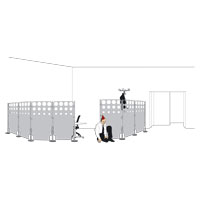
Flumet's drawings plunge us into an odd domestic universe. At the center of her strange world lies the object: a mirror, a folding screen, an armchair, a table, a wall, objects or architectural elements that are functional first and foremost and whose use, on the face of it, harbors neither secret nor surprise. And yet...
These large-format drawings depict figures in indoor settings which are easily identified thanks to the stereotypical furnishings (living room, kitchen, office, and so on). Flumet's use of the clean-lined vectorial drawing and the broad areas of saturated color offers a clear-cut view of the situation; surfaces are sharply delineated while no details clutter up the scene, suggesting restraint and rigor.
Yet this apparent legibility, tinged as it is with a certain decorum, is quickly disrupted, unexpectedly contradicted by the odd position of the figures or their strange activity, making us reread with a fresh eye the theoretically harmless activities in a context that has now become incongruous, and vice versa.
If the situation does become singular it's because the action taking place there is decontextualized (people don't normally practice abseiling while blindfolded and in an office!). That singularity is at odds with its representation, which is squarely situated in a generic or typological register. And the opposite holds as well. An interesting tension arises from this dual movement for it pokes fun at the very idea of leeway or discrepancy, and inevitably engages the viewer's critical eye (1).
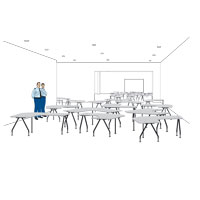
Flumet likes to work by series. In each, through a precise, minimalist mise en scène, she introduces a possibility of incompatibility in the use of the object. Her Mobilier (Furniture) series from 2004 plays havoc with our expectations by offering us situations that are uncalled for to say the least... That woman, for instance, shown scaling her bookcase or the couple comfortably installed in their living room, each of whom is armed with a hunting rifle.
Then there's Voyance (2004), which features a range of preposterous situations in which the very term "voyance" (clairvoyance) enriches its semantic field with new beliefs by playing on the association of ideas. We see a woman and a man in a suit bent over a crystal ball in a stately room that looks like a presidential office...
Aménagement du Territoire (Town Planning), another series dating from 2004-05, makes use of the idea of compartmentalization and its opposite. The piece forces into one and the same space, or rather onto the same plane of reading, two dissimilar spaces. By weaving a decorative-like visual link between the inside and the outside (which we see through a window or broad picture window), the represented space merges not only interiors and exteriors, but also the representation devised for them.
Flumet generates a displacement of surfaces, a shift of planes, which create an unstable domestic world thanks to the proximity she engineers: a garden pavement spills into a living room, or wallpaper with decorative bird motifs adjoins wood panels on one side and a French door on the other that opens onto a sham exterior. The viewer no longer knows where exactly the wallpaper begins and ends.
As for Flumet's series Hors-Limite (2005), by associating tidy, spic-and-span office interiors with extreme sports, the piece emphasizes even more the break in the tenuous connection that seems to link our activities with our surroundings and validate their pertinence. Hors-Limite thus invites us to broaden our horizons or at the very least become aware of their narrow confines.
These unusual combinations between an activity and a context evoke an unexpected chain of relationships which the eye quickly catches and the imagination seizes on in order to envisage the resulting critical force and measure the dramatic potential. Picking up on the detail that doesn't quite fit, the viewer is thrown into a loony story and realizes the fragility of the connections making up the surrounding world. The merest trifle and the whole thing suddenly tips over into a new state.
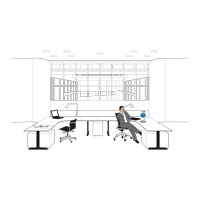
Flumet certainly has a sense of humor and can, without seeming to, mercilessly tear into a dominant way of living and doing that is touted as the norm.
There is then a norm or norms in force which, if they exist, inevitably refer either to something beyond the norm or to a fringe, marking out both deviance and freedom. And it is that interstice that Joëlle Flumet explores, testing the effect of the minor discrepancies and shifts that she orchestrates with intelligence.
Isabelle Aeby Papaloïzos
(1) ...my drawings attempt to render something that has both the singular and the common about it, that contrasts the complexity of the particular case with its generic, categorized representation. I question these two points of view by testing the elasticity of that margin: at what point is a certain behavior considered deviant?" Joëlle Flumet
Andreas Kressig
"Andreas Kressig's work takes shape in a specific place and given time. It is made to measure, so to speak, and fits precisely into the given space-time. A piece will comprise a wealth of objects, either bought or borrowed, that create a mute cacophony when all brought together... This is commonly called an installation but the artist prefers the term plastic improvisation.
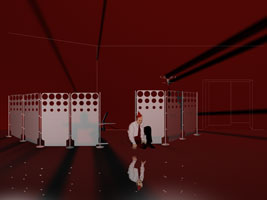
Kressig's treatment of light and space are more important. The space is transformed by subtraction or addition, by simply shifting objects or the light. And for a short time now his experiments in light-filled spaces have been including 3-D imagery that can be confined to a screen or may burst out in the real projection space."
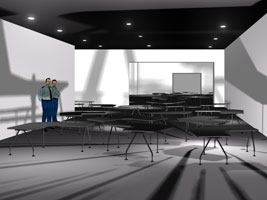
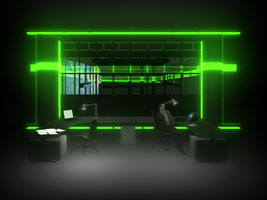
Excerpts from the introduction to the 2005 portfolio by Andreas Kresssig
* Signature informatique d'Andreas Kressig.
JOËLLE FLUMET
Jöelle Flumet was born in 1971 in Geneva. She lives and works in Geneva.
1996: Diploma of the Ecole supérieure des Beaux-Arts of Geneva (média-mixtes)
SOLO SHOWS
2006
"The Bright Side of (The) Moon #2", Joëlle Flumet - Jérémie Gindre, Atelier 304, Usine, Genève
"Urban spaces in post-soviet Armenia", Akanat Gallery, Erevan, Arménie
2004
«Petites dramaturgies de mode d'emploi», Palais de l'Athénée, Geneva [catalogue]
«Intérieurs», Galerie M-Project curated by Edward Mitterrand, Paris
«Intérieurs & Mobilier», Galerie Edward Mitterrand, Geneva
2003
«Plat du jour», Galerie Stargazer, Geneva > avec Laura Solari
Intégration architecturale permanente, Ecole du Bouveret, Valais > avec Nicolas Fournier
Commande publique, Bonnard & Voeffray architectes et commune du Bouveret
«Projet sous verre», Galerie Piano Nobile, Geneva
2000
«Dimensions sur fauteuil rembourré», Galerie Stargazer, Geneva
GROUP SHOWS (selected)
2006
"Make room for the invisible man", Forde, Genève
"Migrations", Chêne-Bourg, Genève
"RADIO", diffusion de pièces sonores sur Internet, projet réalisé avec Jérôme Leuba, Laura Solari et les Editions Dasein, Paris [cat. + DVD audio] www.surinternet.org
Swiss Art Awards, Bâle [cat.]
2005
«Office world», Espace culturelle de la tour OFS / Office fédéral de la culture, Neuchâtel
«Liste 05», Galerie Edward Mitterrand, Basel
«MIX-m.org», curated by Fabric|ch et Simon Lamunière, Centre d'art contemporain, Geneva
2004
«Swiss Art Award 2004», Basel [catalogue]
«Un cabinet de curiosités», Galerie Piano Nobile, Geneva
«Particules accélérées», ForuMeyrin, Geneva
FIAC, Galerie Edward Mitterrand, Paris [catalogue]
2003
Exposition des lauréats des bourses des Fonds Berthoud, Lissignol-Chevalier et Galland 2002, Centre d'art en L'Ile, Geneva
2002
«Joëlle Flumet / Florance Plojoux», Centre d'art contemporain, Geneva
«Première annale genevoise d'art contemporain», Usine Kugler, Geneva
Bourses des Fonds Berthoud, Lissignol-Chevalier et Galland, Centre d'art contemporain, Geneva
2001
Bourse Kiefer-Hablitzel, Basel
«Record collection», Forde-espace d'art contemporain, Geneva
«Analogue-Dialogue», Musée jurassien des arts de Moutier, Kunstmuseum de Soleure [catalogue]
«Mrs & Mr Winter», Usine, Geneva
ANDREAS KRESSIG
Andreas (Georg) Kressig was born in 1971 in Paris. He lives and works in Geneva.
1993: School of the Art Institute of Chicago (Art and Technology)
1997: Diploma of the Ecole Supérieure d'Art Visuel of Geneva (média-mixtes)
2006: Doctorat, Media Art in the Kyoto City University of Arts
SOLO SHOWS (selected)
2004
«L'Epervier», Espace Piano Nobile, Geneva
2003
«Database», Honyarado, Kyoto
2002
«Wakaawawana», 102, Grenoble
2001
«A4», Tokonoma, Geneva
2000
«Jeepshhow», Planet22, Geneva
«________ !», Austellungsraum Kölnerstrasse 334, Düsseldorf
«Knochen», Horten, Düsseldorf
GROUP SHOWS (selected)
2006
«Swiss Art Award 2006», Halle 3.2 Foire de Bâle
«Sarajevo-Kyoto», Galerija 10m2, Sarajevo
2005
«Microscopium, message salon», Zurich
«International Conference of Independent Art Spaces», Valparasio (Chile)
2004
«Entrez !», Villa Bernasconi, Geneva
«Last Show» , Festival d'Art du « Musée en plein air » ; Canal de Kobe
«Exposition des soroptimistes pour les étudiants étrangers» ; Muko (Préf. de Kyoto)
2003
«Deutsch-Französische Freundschaft», Galerie Eigen-Art, Stuttgart
«Expulse», A0, Geneva
«Nichijuu», Galerie Sowaka, Kyoto
«Exposition de la Kyoto City University of Arts (KCUA)», Musée des Beaux-Arts de Kyoto
2002
«Exposition des étudiants étrangers de la KCUA», Centre d'Art de Kyoto (Galerie Nord)
«Ima», Projet de Norbert Brunner, Kobe Harborland, Kobe
«Exposition de la KCUA», Musée des Beaux-Arts de Kyoto (Annexe)
2001
«Exposition de la section conceptuelle et média-art», Galerie de la KCUA, Kyoto
«Exposition des étudiant étrangers de la KCUA», Centre d'Art de Kyoto (Galerie Sud)
«Projet No 13», Volxheimer Kunstverein e.V., Volxheim (Allemagne)
«Bricolages», Shed in Eisenwerk (Projektraum), Frauenfeld
2000
«It is the beginning of a real good friendship», Kunstverein Düsseldorf
«Liste 2000-The Young Art Fair», Galerie Bochyneck, Werkraum Warteck, Basel
